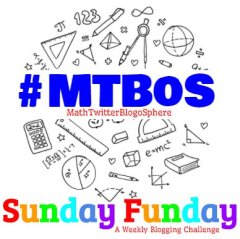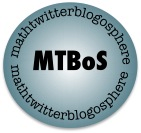I didn’t quite mean for it to turn out this way, but apparently I only go to Twitter Math Camp (TMC) in odd-numbered years, so this was one of those years. The last two TMCs I attended (TMC13 in Philadelphia and TMC15 in Claremont, CA), I rode the train because I generally find it a more relaxing way of traveling. Unfortunately, the only way to go by train from Fort Worth to Atlanta was through Chicago (!), so I flew this time. Because I was attending the Desmos Pre-Conference, I arrived on Tuesday. One of my goals for this conference was to force myself to be socially outgoing because I know there are things I have missed out on in the past, so when Heather Kohn (@heather_kohn) offered to lead a pre-pre-conference tour of Atlanta, I signed up for a tour of the Georgia Aquarium. I wasn’t necessarily interested in seeing the Aquarium (although I’m very glad that I did — it was incredible!), but I wanted the opportunity to meet some people ahead of the conference and so have some built-in familiar faces for when the conference started.
The Desmos conference was very interesting. I ended up in a two-person session on Polygraphs with Chris Danielson, and we actually ended up playing the polygraph I created for my Astronomy class — which was great, because it made me realize that I needed to edit the pictures to make the names more readible. We ended up working on a possible polygraph idea for parallel lines and transversals, which I’m definitely going to work on this year.
The other session that I found interesting was First Steps with the Computation Layer. This has kind of been my summer for programming, and I thought it would be interesting to drill down into what makes Desmos tick. It was fun, in a frustrating kind of way, but I’m not sure the additional flexibility is really worth my time investment right now.
Again, trying to be more outgoing, I spent the evening playing games with a table of guys — thanks Chris (@Plspeak), Jonathan (@rawrdimus), Bill (@roughlynormal), and Josh for making me welcome!
Thursday, the actual TMC17 conference began. Here are my recaps and takeaways:
Morning Session: Playing with Exeter Math
I already wrote up how much of a blast I had in this session. Part of the reason I chose this session is because my summer conference load has been pretty heavy and I wanted some time just to play with math. The other reason I chose this was to give me an opportunity to experience math from a student’s perspective — expecially the frustrations that happen when you can’t quite get things to work the way you want. I was very glad I picked this session!
Session #1: “An Object to Think With”: The whole body as a tool for mathematical sense making by Malke Rosenfield and Max Ray-Riek
This didn’t really turn out to be what I thought it was. We ended up making 3-D structures out of rolled-up newspaper sticks and tape. What I found interesting was the way Malke and Max facilitate the session: they started us up very open-ended and added structure as we went along. It was also fascinating how different the three groups’ structures were (my group’s was very free-form). I’m not sure what takeaways I have for my classes, but it was a lot of fun.
Session #2: Expos: Student Presentations in Math Class by Matt Baker and Kat Glass
I really found this session to be interesting because they use student presentations to (a) review before tests and (b) practice giving presentations. I especially liked the rubric that they shared with us. I already do presentations in Astronomy, and I think I’m going to add giving students grades on how they work in their groups on the presentation. Part of me really wants to have my Geometry students do presentations for review and part of me is a little nervous about the time commitments by both the students and me.
Session #3: A Trig Exploration: Exact Values and the Golden Triangle by Rachel Kernodle, Jamie Collins, and Molly Tanner
This was a whole lot of fun! After refreshing our memories of 45-45-90 and 30-60-90 triangles (and the corresponding trig values), we were then given a 36-72-72 triangle and asked if there was any way we could use this to find more exact trig values. Very cool!
Session #4: CO + DE = MATH by Stephanie Reilly and Tamar McPherson
This might be one of the most useful sessions I attended at TMC. One of the reasons I’ve been getting back into programming is because I think there’s got to be some way to correlate the logical thinking from programming with the logical thinking in Geometry. This session may have given me a really good tool by introducing me to Trinket.io. Until my laptop’s battery died, I was able to take their templates and build a tool for finding the third side of a right triangle, as well as one for calculating the distance between two points. I’m definitely going to be playing with this as school gets started!
Session #5: An Hour of Codebreaking by Bob Lochel
This was a fun session to play with different types of code makers and code breakers. The simulation of the Enigma machine especially boggled my mind. I’m not sure how much (if any) I can use in Geometry, but it was a good session.
Session #6: Clothesline Math by Chris Shore
I was so happy they added this session on because this I wasn’t able to attend his earlier presentation. I’m not sure I can adequately convey how much my mind was blown by the simple arrangement of some paper markers on a piece of string. For the initial stages, it was interesting to discuss what was the absolute minimum amount of information needed to fully represent  ,
,  , and
, and  on a number line; and I also enjoyed the discussion generated by placing
on a number line; and I also enjoyed the discussion generated by placing  ,
,  , and
, and  on a number line containing 0, 1, and
on a number line containing 0, 1, and  . It wasn’t until we were looking at solving an equation,
. It wasn’t until we were looking at solving an equation,  that things exploded. On the number line, we placed
that things exploded. On the number line, we placed  and
and  clothespinned together. Chris then had us place
clothespinned together. Chris then had us place  and
and  , and that’s when we realized that
, and that’s when we realized that  had to be 9 units away from the equality on the left and
had to be 9 units away from the equality on the left and  was 6 units away on the right. The gap between was 15, which was
was 6 units away on the right. The gap between was 15, which was  . Wild! From a teacher standpoint, Chris also gave us some good words of advice, such as making sure the students not at the board have whiteboards or the equivalent, so they have something to do.
. Wild! From a teacher standpoint, Chris also gave us some good words of advice, such as making sure the students not at the board have whiteboards or the equivalent, so they have something to do.

This post has gone on too long, but I don’t want to forget about my favorite My Favorites:
What Else Can Google Slides Do? by Jennifer Fairbanks
Dynamic Web Sketches by David Petro
Maybe next year, I’ll be able to break my pattern and go to TMC18, even though it’s an even-numbered year!



